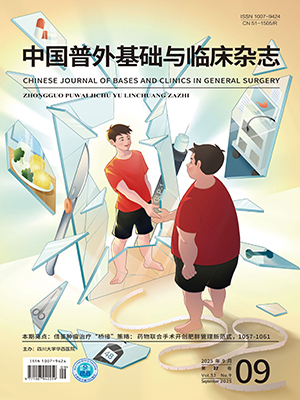| 1. |
中国临床肿瘤学会胃肠间质瘤专家委员会. 中国胃肠间质瘤诊断治疗共识(2017年版). 肿瘤综合治疗电子杂志, 2018, 4(1): 31-43.
|
| 2. |
Huang H, Liu YX, Zhan ZL, et al. Different sites and prognoses of gastrointestinal stromal tumors of the stomach: report of 187 cases. World J Surg, 2010, 34(7): 1523-1533.
|
| 3. |
Muranushi R, Hoshino K, Hagiwara K, et al. Hepatic pleomorphic leiomyosarcoma after surgery for gastric gastrointestinal stromal tumor: a case report. Surg Case Rep, 2019, 5(1): 62.
|
| 4. |
Costache MI, Ioana M, Iordache S, et al. VEGF expression in pancreatic cancer and other malignancies: a review of the literature. Rom J Intern Med, 2015, 53(3): 199-208.
|
| 5. |
杨显金, 陈佳慧, 杜江, 等. 胃肠道间质瘤的诊治现状与进展. 中国普外基础与临床杂志, 2014, 21(8): 1040-1045.
|
| 6. |
Yang J, Gu Y, Huang X, et al. Prognostic impact of preoperative neutrophil-lymphocyte ratio for surgically resected gastrointestinal stromal tumors. Medicine (Baltimore), 2019, 98(16): e15319.
|
| 7. |
Parab TM, DeRogatis MJ, Boaz AM, et al. Gastrointestinal stromal tumors: a comprehensive review. J Gastrointest Oncol, 2019, 10(1): 144-154.
|
| 8. |
岳欣, 胡均, 王家仓. 甲磺酸伊马替尼治疗手术无法切除的晚期胃肠间质瘤. 中国肿瘤临床, 2016, 43(23): 1049-1052.
|
| 9. |
Feng Y, Wang X, Wang Q. Expression of SATB1 and E-cad in tissues of patients with endometrial carcinoma and the relationship with clinicopathological features. Exp Ther Med, 2018, 15(5): 4339-4343.
|
| 10. |
Villagrasa P, Díaz VM, Viñas-Castells R, et al. Akt2 interacts with Snail1 in the E-cadherin promoter. Oncogene, 2012, 31(36): 4022-4033.
|
| 11. |
金鑫, 李靖, 钱军. ALDH1、CXCR4、E-cadherin在胃癌组织中的表达及与淋巴结转移的关系. 南方医科大学学报, 2016, 36(10): 1390-1395.
|
| 12. |
杨学民, 李朝路, 李兆阳. ICAM-1、MMP-9及E-cadherin在结直肠癌中的表达及意义. 癌症进展, 2018, 16(10): 1284-1287.
|
| 13. |
Kövecsi A, Gurzu S, Szentirmay Z, et al. Paradoxical expression pattern of the epithelial mesenchymal transition-related biomarkers CD44, SLUG, N-cadherin and VSIG1/Glycoprotein A34 in gastrointestinal stromal tumors. World J Gastrointest Oncol, 2017, 9(11): 436-443.
|
| 14. |
Lim SC, Jang IG, Kim YC, et al. The role of E-cadherin expression in non-small cell lung cancer. J Korean Med Sci, 2000, 15(5): 501-506.
|
| 15. |
Kim NG, Koh E, Chen X, et al. E-cadherin mediates contact inhibition of proliferation through Hippo signaling-pathway components. Proc Natl Acad Sci U S A, 2011, 108(29): 11930-11935.
|
| 16. |
梁建芳, 郑绘霞, 李宁, 等. 胃肠道间质瘤中P16基因甲基化和P16蛋白表达的临床意义. 中华胃肠外科杂志, 2007, 10(4): 372-375.
|
| 17. |
Ravegnini G, Nannini M, Zenesini C, et al. An exploratory association of polymorphisms in angiogenesis-related genes with susceptibility, clinical response and toxicity in gastrointestinal stromal tumors receiving sunitinib after imatinib failure. Angiogenesis, 2017, 20(1): 139-148.
|
| 18. |
Miettinen M, Lasota J. Gastrointestinal stromal tumors: pathology and prognosis at different sites. Semin Diagn Pathol, 2006, 23(2): 70-83.
|
| 19. |
Hu F, Li H, Liu L, et al. Histone demethylase KDM4D promotes gastrointestinal stromal tumor progression through HIF1β/VEGFA signalling. Mol Cancer, 2018, 17(1): 107.
|
| 20. |
Banys-Paluchowski M, Witzel I, Aktas B, et al. The prognostic relevance of urokinase-type plasminogen activator (uPA) in the blood of patients with metastatic breast cancer. Sci Rep, 2019, 9(1): 2318.
|
| 21. |
Skirnisdottir I, Seidal T, Åkerud H. The relationship of the angiogenesis regulators VEGF-A, VEGF-R1 and VEGF-R2 to p53 status and prognostic factors in epithelial ovarian carcinoma in FIGO-stagesⅠ-Ⅱ. Int J Oncol, 2016, 48(3): 998-1006.
|
| 22. |
Shibuya M. Vascular endothelial growth factor (VEGF) and its receptor (VEGFR) signaling in angiogenesis: a crucial target for anti- and pro-angiogenic therapies. Genes Cancer, 2011, 2(12): 1097-1105.
|
| 23. |
刘景磊, 秦净, 侯英勇, 等. 胃肠间质瘤患者血浆血管内皮生长因子的检测及其临床意义. 中华胃肠外科杂志, 2008, 11(6): 542-544.
|
| 24. |
Basilio-de-Oliveira RP, Pannain VL. Prognostic angiogenic markers (endoglin, VEGF, CD31) and tumor cell proliferation (Ki67) for gastrointestinal stromal tumors. World J Gastroenterol, 2015, 21(22): 6924-6930.
|




